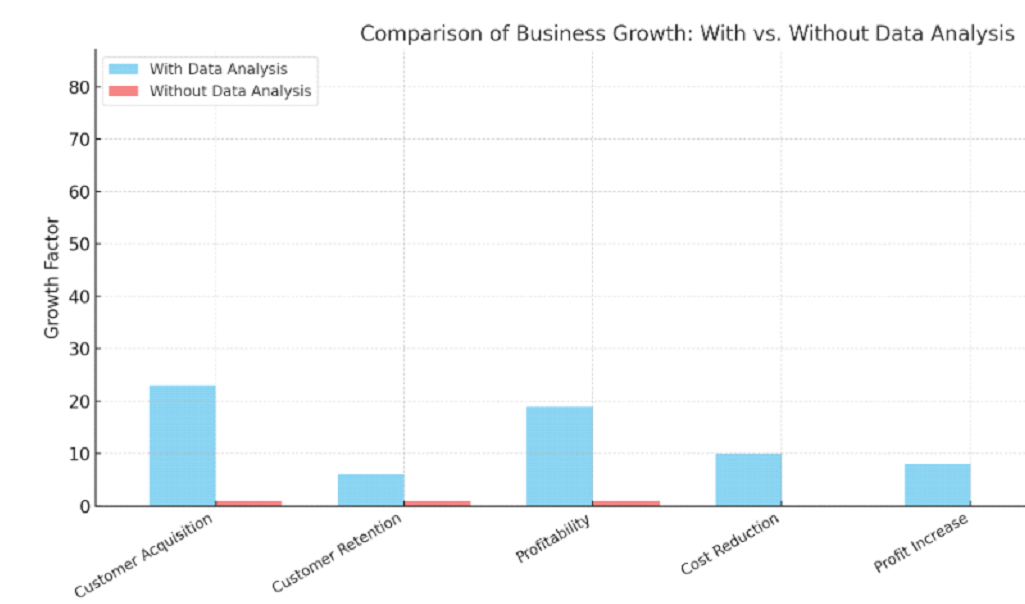The Future of Business: 10 Ways Data Analytics Will Lead the Way in 2025
Business data analytics has become crucial for companies seeking a competitive edge. It involves analyzing raw data to uncover patterns and insights that can improve business efficiency and drive growth. As organizations increasingly recognize the power of data-driven decision-making, the importance of analytics in strategic planning and operational optimization has skyrocketed.

This growing significance is reflected in the bar chart, which compares business growth with and without data analysis across various areas such as customer acquisition, retention, profitability, cost reduction, profit increase, and competitive edge.
The stark contrast highlights the significant advantage businesses gain by leveraging data analysis and the remarkable market growth projections. Even more impressive, the global big data and business analytics market is estimated to reach a staggering $924.39 billion by 2032, growing at a 13% CAGR from its 2023 valuation of $307.51 billion.
The impact of data analytics on business reporting performance is undeniable. Companies leveraging data analytics benefit from various industries’ real-time forecasting, risk mitigation, and process optimization. Research consistently shows that data-driven companies are more productive and profitable than their counterparts who don’t utilize analytics.
As we approach 2025, it’s clear that incorporating data analytics will be crucial for businesses seeking to thrive in an increasingly competitive environment.
The Distinction: Business Analytics vs Data Analytics

As businesses increasingly rely on data-driven insights, it’s crucial to understand the distinction between two closely related fields: business analytics and data analytics. While both disciplines involve analyzing data to inform decision-making, they differ significantly in their focus, objectives, and methodologies.
Business Analytics is primarily concerned with
- future-oriented strategy and
- long-term planning.
- It uses data to forecast trends impacting company performance and inform strategic decisions.
For example, a Business Analyst might analyze past sales data, customer feedback, and market trends to predict future product demand, helping to optimize inventory levels and identify new market opportunities.
Data Analytics has a broader scope and is more immediate in its focus.
It involves:
- Processes such as data cleansing, transformation, and visualization.
- Uncovering patterns and trends in data for various fields and functions.
A Data Analyst might analyze current customer data to identify immediate trends in purchasing behavior, enabling quick adjustments to marketing strategies or product offerings.
The methodologies employed in each field reflect these different objectives. Business Reporting Analytics often utilizes predictive modeling and statistical analysis to forecast future trends, while Data Analytics may focus more on current data analysis and visualization techniques. This distinction impacts how businesses approach strategy and operations.
Business Analytics informs long-term strategic planning and decision-making at higher organizational levels. Data Analytics provides immediate insights that can drive day-to-day operational improvements and quick tactical adjustments.
Understanding these differences is crucial for businesses seeking to leverage data effectively. By recognizing the unique contributions of both Business Analytics and Data Analytics, companies can develop comprehensive data strategies that drive long-term growth and short-term operational efficiency.
10 Ways Data Analytics Will Transform Businesses by 2025

As we look toward 2025, the transformative power of data analytics in business operations is set to reach new heights. Building on our understanding of business and data analytics, let’s explore ten ways these practices will reshape the business landscape in the coming years.
1. Enhanced Decision-Making
Data analytics will continue revolutionizing decision-making processes, enabling businesses to make more informed and agile choices. By 2025, we expect advanced analytics tools to provide real-time insights, allowing companies to respond swiftly to market changes. This agility is crucial, as data-driven organizations are now 23 times more likely to acquire customers, 6 times as likely to retain them, and 19 times more likely to be profitable than their less data-savvy counterparts.
2. Operational Efficiency
Predictive analytics and automation will streamline business reporting processes, significantly boosting operational efficiency. By analyzing patterns in historical data, companies can anticipate bottlenecks, optimize resource allocation, and reduce downtime. For instance, manufacturers can use predictive maintenance to prevent equipment failures, minimizing costly interruptions in production.
3. Customer Insights
Understanding and anticipating customer needs will reach new levels of sophistication by 2025. Advanced analytics will enable businesses to create highly personalized experiences, predicting customer preferences with unprecedented accuracy. This profound insight into customer behavior will drive loyalty and satisfaction, as evidenced by the fact that data-driven marketing leaders are 6 times more likely to gain competitive advantages and increase profitability.
4. Risk Management

Data analytics will play a crucial role in identifying and mitigating potential risks. Businesses can detect early warning signs of market shifts, regulatory changes, or operational issues by analyzing vast amounts of data from various sources. This proactive approach to risk management will help companies safeguard their operations and maintain stability in an increasingly volatile business environment.
5. Innovation and Product Development
By 2025, data insights will be at the heart of innovation and product development strategies. Analytics will help companies identify emerging trends, unmet customer needs, and potential market gaps. This data-driven approach to innovation will lead to more successful product launches and faster time-to-market, giving businesses a competitive edge in rapidly evolving markets.
6. Marketing and Sales Optimization
Data analytics will continue to revolutionize marketing and sales strategies. Businesses can create highly targeted campaigns, optimize pricing strategies, and improve customer engagement by leveraging customer data. The impact of data-driven marketing is significant, with 73% of companies reporting measurable value from implementing significant data initiatives.
7. Supply Chain Optimization
Real-time data analytics will transform supply chain management, enabling businesses to optimize logistics and inventory levels. By 2025, we expect more companies to use predictive analytics to anticipate demand fluctuations, minimize stockouts, and reduce carrying costs. This optimization level will be crucial for competitiveness in an increasingly global marketplace.
8. Financial Performance
Advanced analytics will enhance budgeting and financial planning processes, providing more accurate forecasts and deeper insights into financial performance. Analyzing historical data and market trends allows businesses to make more informed financial decisions, optimize capital allocation, and improve overall financial health.
9. Human Resource Management
People analytics will revolutionize talent acquisition and retention strategies. Companies can predict turnover risks by analyzing employee data, identifying high-potential employees, and creating tailored development programs. This data-driven approach to HR will lead to improved employee satisfaction, reduced turnover, and, ultimately, better organizational performance.
10. Competitive Advantage
By 2025, leveraging big data analytics will be crucial for maintaining a competitive edge. Companies that effectively harness the power of data will be better positioned to anticipate market changes, respond to customer needs, and outperform their competitors. The average ROI for enterprises using business reporting intelligence and analytics is 1300%, underscoring the significant competitive advantage that data analytics can provide.
As we approach 2025, it’s clear that data analytics will be at the core of business success. Companies that embrace these technologies and develop a data-driven culture will be better equipped to navigate the challenges and opportunities of the future business landscape. The transformation by data analytics is not just a trend but a fundamental shift in how businesses operate and compete in the digital age.
Embracing a Data-Driven Future

As we look toward 2025 and beyond, it’s clear that adapting to a data-driven future is not just an option but a necessity for businesses aiming to thrive in an increasingly competitive landscape. The challenges of data privacy, system integration, and skill shortages are significant. A professional IT service provider can provide these services without you having to worry. Data analysis far outweighs the potential for innovation, growth, and enhanced decision-making for a business.
Companies that invest in data analysis will be well-positioned to capitalize on new opportunities, respond swiftly to market changes, and maintain a competitive edge. As the business world evolves, embracing data analytics will be crucial for organizations looking to thrive in the digital age.
Unlock the full potential of your business with Spot On Tech’s cutting-edge data analytics solutions. Our services are designed to streamline your operations, enhance decision-making, and drive growth by transforming raw data into actionable insights. Whether you’re a small startup or a large enterprise, our transparent business reporting and tailored tech solutions ensure you stay ahead in a competitive market. Embrace the digital revolution and transform your business strategy with Spot On Tech. Explore our IT services today and discover how data analytics can propel your business into the future.




